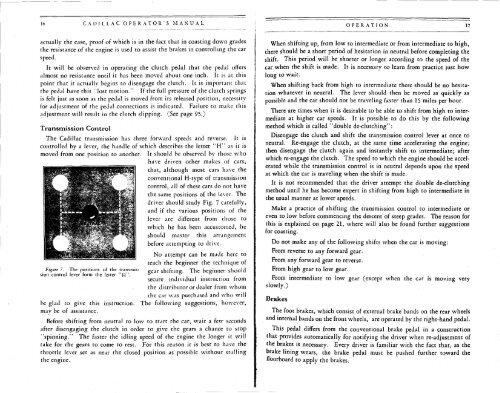1928 Cadillac - GM Heritage Center
1928 Cadillac - GM Heritage Center
1928 Cadillac - GM Heritage Center
Create successful ePaper yourself
Turn your PDF publications into a flip-book with our unique Google optimized e-Paper software.
16 CADILLAC OPERATOR'S MANUAL<br />
OPERATION 17<br />
actually the case, proof of which is in the fact that in coasting down grades<br />
the resistance of the engine is used to assist the brakes in controlling the car<br />
speed.<br />
It will be observed in operating the clutch pedal that the pedal offers<br />
almost no resistance until it has been moved about one inch. It is at this<br />
point that it actually begins to disengage the clutch. It is important that<br />
the pedal have this "lost motion." If the full pressure of the clutch springs<br />
is felt just as soon as the pedal is moved from its released position, necessity<br />
for adjustment of the pedal connections is indicated. Failure to make this<br />
adjustment will result in the clutch slipping. (See page 95)<br />
Transmission Control<br />
The <strong>Cadillac</strong> transmission has three forward speeds and reverse. It is<br />
controlled by a lever, the handle of which describes the letter "H" as it is<br />
moved from one position to another. It should be observed by those who<br />
have driven other makes of cars,<br />
that, although most cars have the<br />
conventional H-type of transmission<br />
control, all of these cars do not have<br />
the same positions of the lever. The<br />
+*M. - *t and if the various positions of the<br />
-¾ * • lever are different from those to<br />
*JBt -I - J<br />
ii -• ••• **? which he has been accustomed, he<br />
• T .*v.,<br />
*s • should master this arrangement<br />
o. ' i<br />
before attempting to drive.<br />
•^Bfr^fcSwJ<br />
Figure 7. The positions of the transmis<br />
sion control lever form the letter "H •<br />
be glad to give this instruction.<br />
may be of assistance.<br />
No attempt can be made here to<br />
teach the beginner the technique of<br />
gear shifting. The beginner should<br />
secure individual instruction from<br />
the distributor or dealer from whom<br />
the car was purchased and who will<br />
The following suggestions, however,<br />
Before shifting from neutral to low to start the car, wait a few seconds<br />
after disengaging the clutch in order to give the gears a chance to stop<br />
"spinning." The faster the idling speed of the engine the longer it will<br />
take for the gears to come to rest. For this reason it is best to have the<br />
throttle lever set as near the closed position as possible without stalling<br />
the engine.<br />
When shifting up, from low to intermediate or from intermediate to high,<br />
there should be a short period of hesitation in neutral before completing the<br />
shift. This period will be shorter or longer according to the speed of the<br />
car when the shift is made. It is necessary to learn from practice just how<br />
long to wait.<br />
When shifting back from high to intermediate there should be no hesitation<br />
whatever in neutral. The lever should then be moved as quickly as<br />
possible and the car should not be traveling faster than 15 miles per hour.<br />
There are times when it is desirable to be able to shift from high to intermediate<br />
at higher car speeds. It is possible to do this by the following<br />
method which is called "double de-clutching":<br />
Disengage the clutch and shift the transmission control lever at once to<br />
neutral. Re-engage the clutch, at the same time accelerating the engine;<br />
then disengage the clutch again and instantly shift to intermediate; after<br />
which re-engage the clutch. The speed to which the engine should be accelerated<br />
while the transmission control is in neutral depends upon the speed<br />
at which the car is traveling when the shift is made.<br />
It is not recommended that the driver attempt the double de-clutching<br />
method until he has become expert in shifting from high to intermediate in<br />
the usual manner at lower speeds.<br />
Make a practice of shifting the transmission control to intermediate or<br />
even to low before commencing the descent of steep grades. The reason for<br />
this is explained on page 21, where will also be found further suggestions<br />
for coasting.<br />
Do not make any of the following shifts when the car is moving:<br />
From reverse to any forward gear.<br />
From any forward gear to reverse.<br />
From high gear to low gear.<br />
From intermediate to low gear (except when the car is moving very<br />
slowly.)<br />
Brakes<br />
The foot brakes, which consist of external brake bands on the rear wheels<br />
and internal bands on the front wheels, are operated by the right-hand pedal.<br />
This pedal differs from the conventional brake pedal in a construction<br />
that provides automatically for notifying the driver when re-adjustment of<br />
the brakes is necessary. Every driver is familiar with the fact that, as the<br />
brake lining wears, the brake pedal must be pushed further toward the<br />
floorboard to apply the brakes.
















